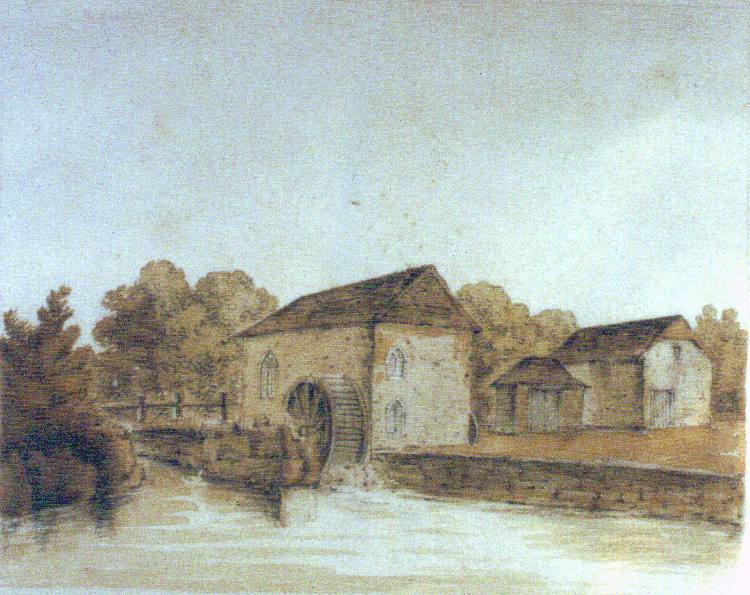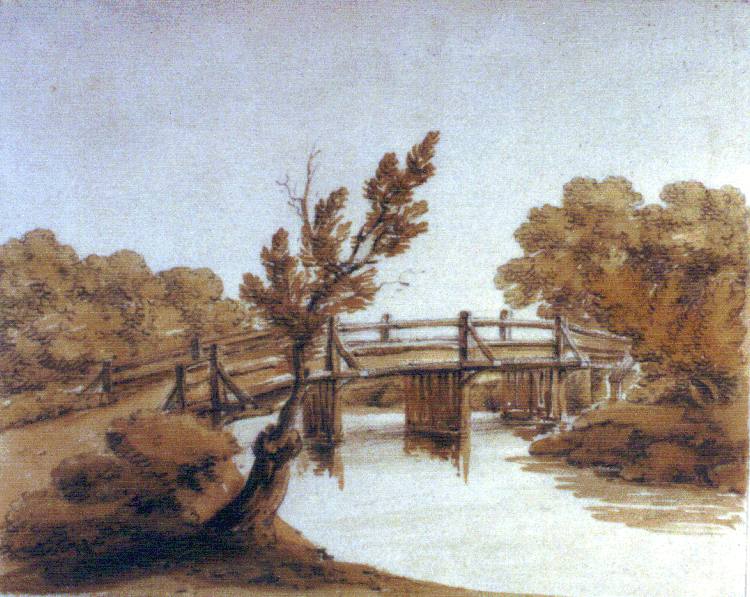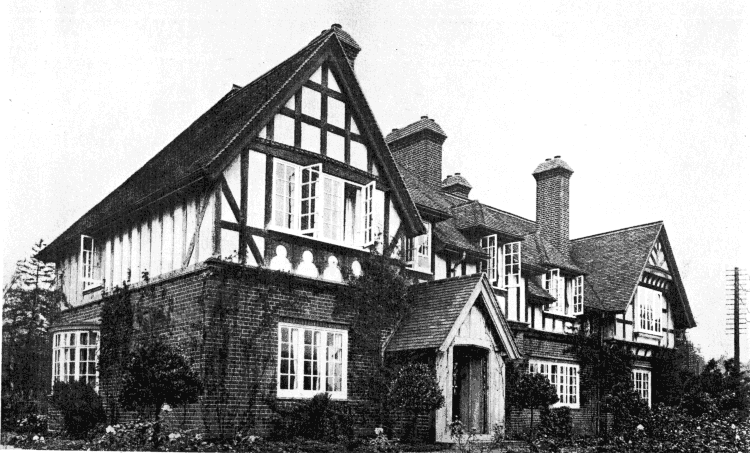


 |
 |
 |
Durnford Mill in 1824 |
Durnford Bridge in 1824 |
Durnford Lodge in 1914 |
According to Stratton (1990) Durnford mill was built in 1797 by Edmund Boehm to replace an earlier one built in 1783 by Sir Thomas Sewell further upstream. A note on an undated (probably 1829) plan of part of the Bourne drawn by the architect Jago states, however, that the Mill was built in 1800. The site of this earlier mill is shown on the Jago plan of 1829. The new mill had two pairs of stones driven by an external breast shot wheel. Later a second water wheel was been fitted to power a saw and a third pair of stones. Adjacent was a house, dairy and garden.The new mill is first shown on the Enclosure Award map dated 1802. A watercolour painting by John Hassell of 1824, now in Chertsey Museum, shows Durnford Mill as a small brick building with a tiled roof. The mill appears to have doubled as a flour mill and a saw mill.
The millstream was fed by the Bourne and its flow controlled by a dam at the point where the millstream left the Bourne. There was apparently some controversy about the water levels in the 1820's as Jago was commission to draw a detailed plans of the water course in 1829. Jago noted that the dam was "broken down" by this date. A few bricks remain to mark the spot and close by, at the point where the millstream leaves the Bourne, there still can be seen the remains of a brick retaining wall.
In 1827 the mill was sold to Thomas Weeding and was no longer part of Ottershaw Park Estate. It remained in the Weeding family until 1887 when it was purchased by Lawrence Baker and re-incorporated into Ottershaw Park once more. The mill does not appear on the OS map of 1897 [1893 according to Stratton] revision, so it was probably dismantled by then. The mill was inhabited in 1881 but not mentioned in the 1891 census so it may have been uninhabited for some time before it was demolished. By the time the 1907 sale catalog was published the mill had gone.
Durnford - Owners:
Date
|
Name
|
Reference
|
| 1783 - 1819 | Edmund Sewell | Stratton |
| 1819 - ?? | Mrs Sewell's Trustees | Stratton |
| ?? - 1827 | Sir George Wood | Stratton |
| 1827 - 1855 | Thomas Weeding | Stratton |
| 1855 - 1884 | Thomas Weeding Weeding | Stratton Electoral registers 1883,84 |
| 1887 - 1910 | Lawrence Baker | |
| 1910 - 1921 | Friedrich Eckstein | |
| 1921 - 1926 | Miss Dora Schintz | |
| 1926 - 1946 | Charles Taylor | Land registry, MOD requisition, will 1945 |
There were numerous millers over the years at Durnford Mill. Some are listed below:
Durnford Mill - Millers:
Date
|
Name
|
Reference
|
Comments
|
| ?? - 1819 | John Howe senior | 1819 sale catalog | |
| ?? - 1827 | John Howe junior | Stratton | John Bartlett 1824? |
| 1826 - 1829 | Mr Mason | George Wood papers 1826, Jago plan 1829 | |
| ?? - 1835 | G.E.Kerason | Stratton | |
| 1835 - ?? | James Mason | Stratton | |
| 1841,55,51,55,59 | Charles Baker (senior) | 1841,51 census, 1855 Kelly's directory | |
| 1861 | Charles (junior) & William Baker | 1861 census | |
1863 - 1874 |
Thomas Taylor | 1871 census, 1867,74 Kelly's directories, 1863-73 Thomas Weeding Weeding's rent book | Leaseholder |
| 1881 | William Taylor | 1881 census | |
| 1882,87 | Edward Hilder | Kelly's directories | (but see below) |
| 1885 | Thomas Taylor | Electoral register | |
| 1887 | Stephen Taylor | Electoral register |
A row of four cottages was built on the site of the old Durnford Mill fronting the Guildford Road and adjoining the South Lodge entrance some time after 1870. The first occupants are recorded in the electoral register for 1890 suggesting these cottages were built during the late 1880's. They were described in the sale catalog of 1907 as "Modern cottages .... very substantially built ... in the Early English style of red bricks and hanging tiles, rough cast and exposed timbering with slated roofs" and were occupied by employees of the estate. The 1907 sale catalog also notes that they were "...well suited to conversion into one residence...".
A plan accompanying the conveyance of 1910 to Friedrich Eckstein shows four cottages still on this site but these were soon converted into a single dwelling which became known as Dunford or Durnford Lodge and, later, Dunford House. The conversion was to a design by Niven & Wigglesworth, the architects of The Mansion. A photograph published in Barker & Barker, shows building work in progress and there are a number of contemporary accounts in architectural journals of this conversion. Dunford Lodge first appeared on the OS 25" map of 1915 (revision based on a survey revison of 1912). A conveyance of 1921 describes " ...the house... called Durnford Lodge formerly consisting of four cottages thereon known as Durnford cottages...".
A valuation survey carried out in Ottershaw Park in 1923 recorded the following description:
"On the First Floor: 7 bed and dressing rooms, bathroom, Housemaids Pantry with sink, W.C.
On the Ground Floor: Porch entrance Hall, Drawing room, Dining room, Office, Cloak room fitted with wash basin and W.C. Pantry with tiled walls and floor, Kitchen, Scullery, both having floors, Larder with tiled walls, Coal cellar, and Servants W.C..... Company's water is laid on, Electric Light is installed, and there is Central Heating.
The Out-Buildings comprise Garage for 2 cars, 2 stall Stable, Harness Room and Tool House, and timber and tiled roofed Poultry House. .... There is a Tennis Lawn. The premises are occupied by the resident Land Agent."
Charles Winslow Taylor, the bailiff or estate agent at Ottershaw Park occupied the lodge between 1910 and 1913 when he was dismissed from his post, but he subsequently purchased the house in 1926 from Miss Schintz. The Ministry of Defence requisitioned the house from 1942 until after WWII. A local resident recalls that the house was occupied by RAF officers and pilots who were learning to fly Hurricanes and Spitfires at Fairoaks Airport were billeted in huts in the grounds. Charles Taylor died in 1945 and his will (proved 25th May 1946) gives his address as the Basil Street Hotel, London. Dunford House, as it was later called, was occupied by a number of stars of screen and stage including for a short period in the 1970's, Russ Conway the popular pianist. Dunford House survives as a private residence and is not part of the present day Ottershaw Park.
Durnford Cottages/Lodge - Occupiers:
Date
|
Name
|
Reference
|
Comments
|
Dunford cottages
built late 1880's
|
|||
| 1890 | George Cranston | Electoral register | |
| 1895 | Edwin
Parsons |
Electoral register | |
| 1900 | Herbert
Sawyer George Trigg |
Electoral register | |
| 1906, 07 | Herbert Sawyer |
Electoral registers | |
| 1908 | Henry Sawyer |
Electoral
register Chertsey UDC rate book |
|
| 1909, 10 | Herbert
Sawyer |
Electoral registers | Trigg & Boniface moved to cottages in Bonsey's Lane |
Dunford
cottages converted to Dunford Lodge 1910 - 1912
|
|||
1910-13 |
Charles Taylor | Kelly's
directories 1911, 13 |
Bailiff/Estate agent |
| 1915,19 | James Baker | Kelly's directories | Land agent |
| 1918-1920 | Frederick John Brown | Electoral registers | |
| 1921 | Frederick John Brown Charles Frederick Mitchell |
Electoral registers | |
| 1922,23 | Charles Frederick Mitchell George William Rose |
Electoral registers | |
| 1924,25 | George William Rose | Kelly's
directory 1924 Electoral register 1925 |
Estate agent |
| 1926-1939 | Charles Taylor | Land
registry Kelly's directory 1930 Electoral registers 1928-39 |
Taylor now owner/Occupier |
| 1942-1946 | MOD | MOD requisition | Transferred to MOH 1946 |
| 1947-1949 | Several families | Electoral registers | Durnford Lodge camp |
| 1970's | Russ Conway | Owner/Occupier | |
| 1970's | Janette Scott and Mel Torme | Owner/Occupier |
|
In addition, the electoral registers record that William Alfred Alderton and his wife lived in The Cottage, Durnford Lodge in 1930 and that Sidney George Jeffrey and his family lived in Gardener's Cottage, Durnford Lodge between 1935 and 1939. The exact location of this building is unknown but was presumably an outbuilding at Durnford Lodge
There has been a bridge at Durnford since at least the mid-16th century. This would have been a wooden construction and there are two early 19th century paintings of the bridge (John Hassel, 1824 and William Daniel, 1829) in Chertsey Museum. There are some receipts for its repair in the 1850's in SHC. The present bridge was built in 1957/58 when the road was straightened.
There was a decoy at one time on the estate just west of Durnford Mill. It appears on the 1819 Sale catalog map but it was already overgrown by 1829 when Jago produced his map of the mill stream. Decoy plantation just to the North is still marked on modern OS maps. A decoy was used to catch ducks and the one in Ottershaw Park is recorded in the seminal work on Decoys written by Sir Ralph Payne-Gallwey in 1886. Here is what he had to report:
Ottershaw Park, 4 miles SW. of Chertsey.
The remains of an old Decoy are still visible on this estate, formerly the property of Sir Thomas Colebrooke, Bart., but now belonging to Mr. Laurence J. Baren (sic!) . I learn, however, from the bailiff, Mr. G. Coleman, who has lived on the property for thirty-seven years, that it has not been worked within his recollection. And the late owner of the estate, Sir T.Colebrook, informs the Author that there are no traditions existent connected with this Decoy.